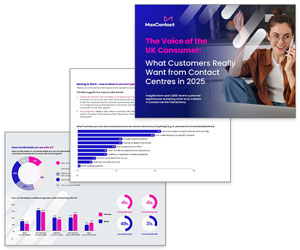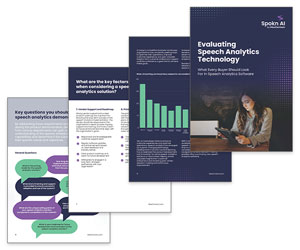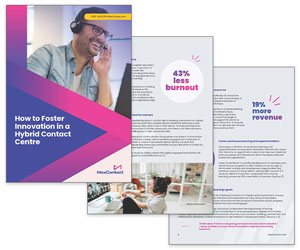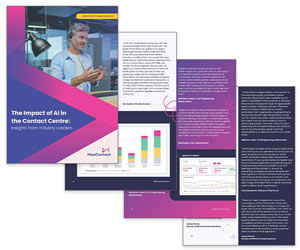Every customer communication with your organisation produces data. Over the course of an hour, day, week, month or year, that can amount to thousands of pieces of potentially useful information. But it’s only useful if you can capture and analyse it. That’s the role of contact centre analytics.
Understanding Contact Centre Analytics
What is contact centre analytics? Think of all the pieces of data thrown up by customer communications. At one end, that can mean simple metrics like the number of interactions your contact centre has with customers on a given day.
At the other, it can be complex statistics on call waiting times or how long agents actually spend speaking on the phone.
Analytics can look at all this, mining it for patterns and insight. It can show how productive your agents are, how smooth your customer journey is, or how your outbound campaign is performing.
It’s easy to see how that can help support your contact centre. Analytics can give you a good idea of performance by comparing real time statistics with historical equivalents or industry averages.
It can show where bottlenecks occur in inbound customer journeys. It can predict whether your outbound campaign will meet its calling targets.
When you have that information, you can start to properly measure and improve what you do.
Data Analytics: Essential for Call Centre Success
Improved Customer Experience
The first thing that data analytics can do is improve the experience of customers. It does so by measuring how long customers have to wait in queues, how long they are kept on hold, or how many attempts they make before connecting to an agent.
When you have that information, you know which areas require improvement. You can segment data and tailor journeys for every customer group.
Identify Customer Needs in Real Time
With analytics, you can create dashboards that show you exactly what’s happening in your contact centre at any given moment, and then act accordingly.
For example, if customers are queuing for too long, you might temporarily divert agents from an outbound campaign to relieve inbound bottlenecks.
If they’re spending too long on hold during agent interactions, that might suggest gaps in agent knowledge that require additional training.
Resolve Customer Queries Quickly
In the longer term, analytics can help resolve customer queries quickly by using intelligent workforce management to ensure you have optimum staffing levels on every shift.
They can also help identify weaknesses in your processes that lead to customer frustration and call abandonment. Analytics can help you design customer journeys that get customers to where they need to be more quickly.
Enhanced Operational Efficiency
How does analytics make contact centres more efficient? In the short term, it lets you allocate resources more optimally. In the longer term, it helps you identify gaps and bottlenecks and take remedial action.
Real-Time Monitoring
Create dashboards that show important metrics in real time. That might be how long it takes to answer incoming calls, or how long agents are spending on each interaction. It could be a multitude of other things, depending on what you do and what your priorities are.
If needs be, you can then share dashboards to a big screen, creating wallboards for the entire contact centre to see.
Let your teams see in real time how they are performing against daily targets, or encourage some healthy competition with a sales leader board.
Improved Resource Allocation
Analytics can also be used to ensure you always have the optimal number of agents per shift, creating the right balance between customer service and cost. Statistical analysis can draw on mountains of historical data to help you meet goals.
Better Decision Making
All of these features of analytics come together to help you make better decisions.
Improved Data-Driven Decision Making
Scores of data points can be amalgamated to produce detailed management reports. These can be standard or bespoke, and give a bird’s eye view of the performance of agents, campaigns, customer journeys and your contact centre as a whole.
When you have this data you can use it to make more strategic decisions, based on real evidence. That might be to invest in training, increase (or reduce) staffing, implement secure payments to save agent time, or a hundred other possible innovations.
Improved Understanding of Customer Behaviour and Preferences
Data can even help you get inside the minds of customers, in a way. Speech analytics trawls huge amounts of data to find both real-time and historical patterns concerning conversations, sentiment and productivity.
It can give you a feel for what customers are thinking, by analysing the words they use, the time they spend on the phone and so on. It can help you identify problems before they result in customers moving elsewhere.
3 Things to Consider Before You Implement Analytics
Not all analytics are the same. Here are three things to consider so you get the right system for your needs.
Assess Current Contact Centre Operations
Assess what you do now, so you know what you need to measure and how to measure it. Is it mainly inbound, outbound or a mix? Is it mainly customer service, payments or sales campaigns?
Think about what you do, where you see perceived weaknesses and how analytics might be able to help.
Identify the Right Tools and Solutions for Analytics
Then think about the analytics tools that could help you be better. There are many standard metrics like average handling times and call waiting times.
But do you need to go deeper, with speech analytics or intelligent workforce management? Do you need customised reporting, or will standard templates be good enough? Make sure you explore the right tools for the job.
Ensure Data Security and Privacy
When you’re dealing with customer information, even as part of huge data sets, you have to be lock-tight secure and fully compliant with all data privacy regulations. Make sure your chosen system has the certifications to back up any claims.
Best Practices for Contact Centre Analytics
How do you get the most from contact centre analytics? Here are four best-practice tips.
Regular Monitoring and Review of Data
If you’re gathering all that valuable data, make sure you use it. Put processes in place to ensure regular monitoring and reviews and organise frequent sessions that explore what the data is saying.
Provide Training and Support for Agents
If analytics identifies weaknesses in agent knowledge or approach, close those gaps with proper training or one-to-one sessions with team leaders. Give agents what they need to get better, and see your call centre metrics improve over time.
Continuous Improvement and Optimisation of Analytics
The more you use analytics, the more useful it becomes. Add data points over time or create bespoke reports that better meet your business needs.
Implement a Data-Driven Culture
When you have experience in analytics, use it throughout your organisation. Data-driven insight can help with agent productivity and career progression, campaign design, refining customer journeys, and making strategic investment decisions. They say data is the new oil. Use it to power your business from top to bottom.
Maximise Your Customer Insights
Data is powerful. So much so that it’s almost impossible to think of a major business that isn’t trying to harness the power of data to improve outcomes.
Modern contact centres have to consider data and the analytics tools that can gather and interpret that information, because your competitors will. Data gives you invaluable insight into customer sentiment, agent productivity, campaign performance and much more.
The best analytics platforms will provide all the insight you need to improve the contact centre experience for agents and customers, and present it in a way that is easy to understand and action. Analytics is an essential tool for every contact centre that wants to get better and bigger.
This blog post has been re-published by kind permission of MaxContact – View the Original Article
For more information about MaxContact - visit the MaxContact Website
Call Centre Helper is not responsible for the content of these guest blog posts. The opinions expressed in this article are those of the author, and do not necessarily reflect those of Call Centre Helper.
Author: MaxContact
Published On: 1st Jun 2023
Read more about - Guest Blogs, MaxContact






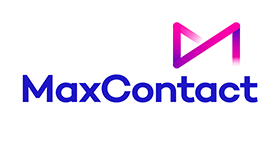 MaxContact is customer engagement software that goes above and beyond to build smarter customer experiences. Our platform is packed with powerful features, accessible for businesses large and small, and ensures organisations can operate compliantly.
MaxContact is customer engagement software that goes above and beyond to build smarter customer experiences. Our platform is packed with powerful features, accessible for businesses large and small, and ensures organisations can operate compliantly. 




